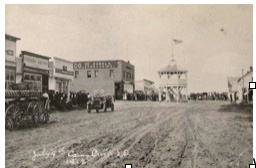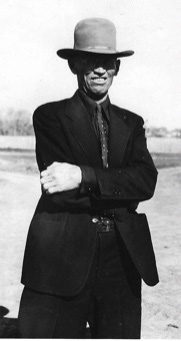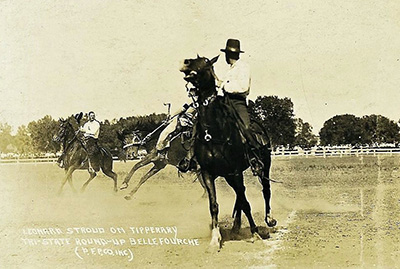When the northwest corner of South Dakota was opened up for homesteading brothers Fredrick and Charles Wilson rode up from the Black Hills to stake their land claims. Charles Henry Wilson was born at North Acton, Mass. on Dec. 30, 1876 and moved to the Black Hills in 1879. Charley passed away Oct. 5'" 1926 at his ranch In Harding County. He moved to Harding County in 1893. Charley Wilson married Florence Cooper from Harding. She was a sister of Mrs. Maude Cornell and Grace Hammon. Charley Wilson rode with the Seth Bullock Cowboys in the Teddy Roosevelt Inauguration parade. Charley Wilson, as we knew him, was the proud owner of Tipperary and Tip Top, the famous bucking horses that Charley took all over for the big rodeos and at Belle Fourche and Buffalo. He even took them to New York's Madison Square Garden where the boys would do their best to ride these Harding County broncs.
The Charley Wilson ranch was over in the Jump Off area, towards the town of Harding. They had two sons: Harold and Arthur, who was married to Margaret Kliener and had 3 children, Denis, Julie Ann, and Lisa Wilson. I have no more records on this family.
Fredrick W. Wilson was born in Acton Mass. on Oct. 14, 1874 and passed away on January 3rd 1946. He came to this country from Acton, MA with his folks in 1879 to the Black Hills where he attended school. In 1896, he homesteaded east of the Jump Off, just south of the Camp Crook road and west of Buffalo. He served as county auditor, register of deeds, clerk of courts and he served on the selective service board through both World Wars.
Fred was also one of Seth Bullock's Cowboys that rode in Teddy Roosevelt's Inauguration parade. He was a member of Cedar Branch Lodge #179 and the local Eastern Star. Fred married Harriet (nicknamed Hatti) Adams from Terraville, SD in 1899. She was a sister to Will Adams who worked in the Harding County Bank and was married to Molly Smolnikar. Will and Molly moved to Miles City where he hauled mail. Three children were born to Fred and Hatti; Amy, Ruth, and Frederick. Their home in Buffalo was just north of the Congregational Church. This house is still owned by the Wilson family. Harriet Wilson was born July 22, 1877 In McVeytown, Pennsylvania and passed away July 4'" 1970 at the age of 92. Hatti was a member of the Congregational Church and the Order of the Eastern Star. Fred and Harriet Wilson's son, Frederick born July 3rd 1913 graduated from high school In Buffalo, SD.
After graduation from the University of Wyoming at Laramie, Frederick taught In Moorcroft, WY for 2 years. While In Moorcroft, he met and married Barbara (nicknamed Nedzy) Slater from Ridge, Montana. Barbra had graduated Sundance high school at 15, attended teachers training and taught for six years in Wyoming. This was in 1939. He then taught in Cokeville, WY before coming back to Buffalo to become the Superintendent of Buffalo School. Fred was the Superintendent and taught high school In Buffalo for several years before joining the S.D. Extension Service and moving to Spearfish, SD. After about 3 years In Spearfish, the Wilsons moved back to Buffalo where Fred became the Harding County Extension Agent. During this time, the family moved to the Wilson Ranch west of Buffalo. Frederick was the County Agent for several years before becoming a full time rancher. Fredrick and Nedzy were among the first ranchers In Harding County to begin improving their livestock through artificial insemination.
During this time Fred and Nedzy ran a slaughter house, they processed livestock and wild game for many years. They taught their kids to cut and wrap meat. Fred was a member of Cedar Branch Lodge #179. Frederick and Barbara were the parents of 7 children, 2 boys and 5 girls. Freddie, as they called him, had many good friends and was quite a good athlete in his younger days. He passed away suddenly at his home west of Buffalo in 1975 at the age of 61. Barbara owned and operated the Harding County Abstract Office for many years. Barbara passed away March 9th 2006 at the age of 91.
Their children are as follows: Terrill worked as a nurse for many years. She also owned a flower shop in Minot, ND. She lives In Leesburg, Florida. Terrill has 2 daughters, Dawn and Jackie. Sharon married Leonard Jenkins while he was In the U.S. Navy. They moved around a lot before Leonard retired. Sharon and Leonard had 3 children - Bill, Barbara, and Debora. They moved to Buffalo, SO after Lenny retired from the navy in 1975. They purchased the Buffalo Trailer Court, built a new Laundromat and carwash on the property. They operated it and the campground together until Lenny died on Aug. 1, 1998. Sharon continued running the business until 2003 at which time she sold it and moved to Summerset, SD. Barbara Wilson was an Edward Jones stockbroker for over 20 years. She is now retired and lives In Tazvares, Florida. Barbara has two children Steve and Terri. Fred married Judee Foster and lives between Belle Fourche and Newell. They are the parents of 3 children - Freddie Bill, Anne-Marie, and Josh. Unda Wilson is a teacher for special education students in Leesdurg. Florida. Tom married Lori Stensland and they live on the Wilson ranch west of Buffalo. They have 4 children - Kyle, Blake, Reed, and Shanna. Tom and his sons are also members of Cedar Branch Lodge #179. Julie married Mike Upperelll and lives in Eustis Florida. They have two daughters Julia and Jessie. Neighbors to the Wilson ranch are and were Lawrence and Eldora Licking and their boys Larry, Leonard, and Gary (who is still on their ranch) lived to the west. On the Oakley Lamphere place to the north were: Don and Farrol Thompson and their children Tedd, Zane, Rock, and Jody lived there 1st. Dennis and Rita Thompson and their children Frank and Ann lived there next. Then the ranch was sold to Joe Verhulst and Dave and Paula Smith moved in with their children Cheri, Troy, Jody and Travis. To the east lived the Al Salmen and the Dean and Lola Oja's and their children Tami and Cheri. To the South was the Edward and Ethel Waara and their children Boyd and Carmen. Beside them were the Bud and Willo. Heairet and their children Mark, Donna, and Susie. The Hanify Ranch was to the South west which was then the Delaine and Mauria Jo (Hanify) Nixon and their children Kerry, Molly, and Robin. They sold the ranch to Tim Birk and George and Nancy Yarbough and their children Erin and Lea.
Rest of the Tipperary Story
Tipperary was the famous bucking horse that did his part to make the Tri-State Roundup the success it was in 1918, up until his last performance July 6, 1926. The horse was 21 years old. “Old Tipperary had lost none of his pep in spite of his years. Howard Tegland, one of the best and nerviest busters in the game, made a beautiful ride on Tipperary Tuesday but failed to qualify as he could not ride him to the finish. He slid to the ground without conquering that old invincible bucker on July 6, 1926.” There were 31,000 people in attendance for the ninth annual Round-Up show.

In the beginning, Tipperary was born in 1905, on a ranch near Camp Crook, SD. Tipperary was a dark bay gelding, without any white on him. He was branded with FR. He stood 15 hands and weighed around 1500 pounds. Horse ranching was a big deal along the Little Missouri, probably all of Harding county from the homestead days – 1900 until after WWI. Many of the world’s army still used calvery units so they needed horses. “The English were very selective. French buyers were careful but the Italian buyers only checked to see if the horse was still warm before they bought it. So, the market was good for nearly every kind of horse.”
Tipperary was a pacer – which means his legs moved in lateral pairs. He was foaled into Elmer Wickham’s herd. Wickhams were one of the first settlers in the Camp Crook area; in fact Camp Crook was originally called Wickhamville. When he was 4 years old, Elmer hired Fred Wheat to break the horse. Tipperary was tied to a log to tame him, but a lightening storm blew up and caused the horse to break out of the coral. The breaking effort was given up and Tipperary spent the next six years living off the prairie.
 In 1915, horses were bringing a good price because of buildup of militaries in Europe preparing for WWI. Ed Marty told Elmer Wickham that he would ride Tipperary. The plan was to bring the outlaw to Camp Crook.
In 1915, horses were bringing a good price because of buildup of militaries in Europe preparing for WWI. Ed Marty told Elmer Wickham that he would ride Tipperary. The plan was to bring the outlaw to Camp Crook.

By late 1916, Charlie Wilson was the sole owner of Tipperary. Charlie loved horses and proved to be a natural horseman. He was one of Teddy Roosevelt’s Rough Riders. He attended Teddy’s 1905 Presidential Inauguration with the 1902 Cowboys. During the parades, they stole the show. Mr. Wilson took to stock contracting after his purchase of Tipperary. He resented any suggestion that his rodeo stock was abused in any way. Charlie believed in trailing his rodeo stock whenever possible rather than using trucks or trains. He believed that the exercise kept them in top bucking form, and results proved him right. Another of his outstanding bronc was Tip-Top. Charlie Wilson died October 7, 1926.
Charlie established certain rules for riding his broncs, especially Tipperary and Tip-Top. The bronc busters had to agree to the rules before they were permitted to ride. His rules included riding until the horse stopped bucking unlike present day bronc riding which is a timed event, never “pulling leather,” changing reins or losing a stirup disqualified the rider. During his lifetime, Charles Wilson was probably one of the most widely known men in South Dakota, Montana, and North Dakota. He was known for his honesty, generosity, sportsmanship, and his willingness to work hard for his community and country. There were only 4 “qualified” rides on Tipperary – Harold Ekburg rode Tipperary on Labor Day, September 6, 1926. Harold and the horse were both 21 years old. Harold had worked for Charlie; so he knew Tipperary well. At the Tri-State Roundup in Belle Fourche in both 1920 and 1921, Yakima Canutt rode a qualified ride; but there were always doubts. In 1920, the arena was very muddy and Tipperary tripped. In 1921, Yakima lost his stir-up but regained it before it was noticed by the judges. Finally in Tipperary’s first show in 1916, Rufus Rollins rode him. Rufus Rollins, a seasoned Wild-West performer and bronc riding winner at Miles City’s Round-Up, put on a good exhibit and rode the horse. Tipperary had cut his left foot during the night; that foot would bother him the rest of his life. He had to have a specially built horse shoe.
After 1926, Tipperary was put out to pasture; Art Ritchie, Harding County Sheriff, took over Tipperary and Tip -Top in 1931. In 1932, he was stolen with a bunch of other Ritchie horses and trailed southwest into Montana from the Jump-Off territory with the law in pursuit.. The horses were finally abandoned in a barn. By the time they were resued, old Tipperary was in bad shape. In late October, 1932 he died in a snow storm. His bones were picked up and buried under a memorial in a park in Buffalo. Tipperary and Yakima Canutt were induced into the National Cowboy Hall of Fame in 1976.
Art of Tipperary In 2006, Alvin Cordell who ranches near Camp Crook, commissioned Mick B. Harrison to paint a watercolor scene of Ed Marty’s ride on the street of Camp Crook in 1915. It is titled “Tipperary’s Genesis.” Painting is at the Tri-State Museum.

Rod Nichols, a cowboy poet, then revised one of his poems to go along with the painting. Tex Fletcher, a western singer who spent some time in Buffalo during the ‘30’s and returned later from New York to make a children’s series, wrote several songs about the Harding County area including Tipperary (The Great Outlaw Horse).

Tony Chytka, local sculptor from Belle Fourche, was contracted to create a beautiful bronze of Tipperary. The bronze is part of the Buffalo’s Memorial Park.
Sources: Looking Back In Belle -- These articles came from newspaper microfilm from the Belle Fourche Public library, using a new microfilm reader and printer. The photographs are from the Tri-State Museum. Additional information from Tipperary, The Diary of A Bucking Horse 1905-1932 by Paul Hennessey (local author) and Harding County History published 2013. ~Transcription by Mary Buchholz, Harding Co. SDGenWeb Coordinator

Caption reads - Leonard Stroud on Tipperary
Tri-State Round-Up Belle Fourche
(P.E.P. Co. Inc)
